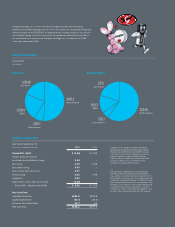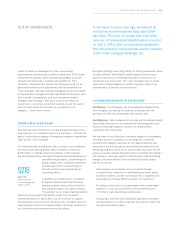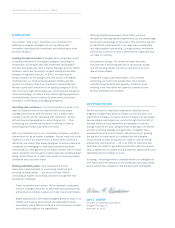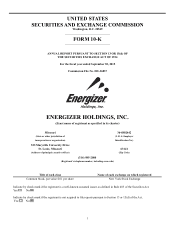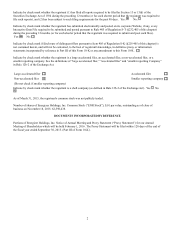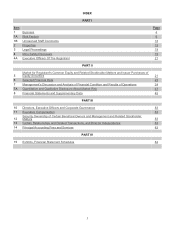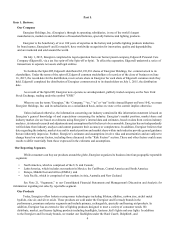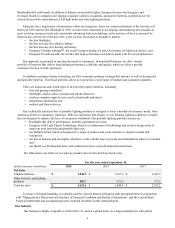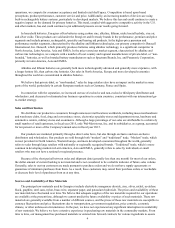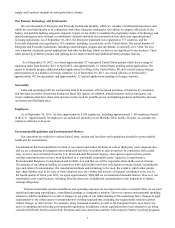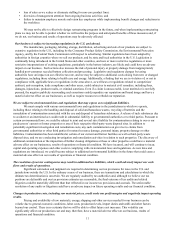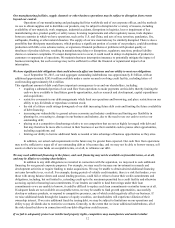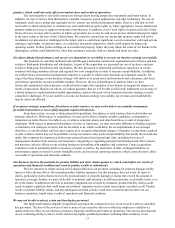Energizer 2015 Annual Report Download - page 10
Download and view the complete annual report
Please find page 10 of the 2015 Energizer annual report below. You can navigate through the pages in the report by either clicking on the pages listed below, or by using the keyword search tool below to find specific information within the annual report.6
operations, we compete for consumer acceptance and limited retail shelf space. Competition is based upon brand
perceptions, product performance, customer service and price. Additionally, an increasing number of devices are using
built-in rechargeable battery systems, particularly in developed markets. We believe this has and could continue to create a
negative impact on the demand for primary batteries. This trend, coupled with aggressive competitive activity in the U.S.
and other markets, has and could continue to put additional pressure on our results going forward.
In household batteries, Energizer offers batteries using carbon zinc, alkaline, lithium, nickel metal hydride, zinc air,
and silver oxide. These products are sold under the Energizer and Eveready brands in the performance, premium and price
segments and include primary, rechargeable, specialty and hearing aid products. In the higher-price premium and
performance market segments, characterized by the alkaline and lithium technologies, our primary competitor is Duracell
International, Inc. Duracell, which primarily produces batteries using alkaline technology, is a significant competitor in
North America, Latin America, Asia and EMEA. In the price-conscious market segment, characterized by alkaline and
carbon zinc technologies, we compete with a number of local country and regional manufacturers of private-label, or “non-
branded,” batteries, as well as branded battery manufacturers such as Spectrum Brands, Inc. and Panasonic Corporation,
primarily in Latin America, Asia and EMEA.
Alkaline and lithium batteries are generally both more technologically advanced and generally more expensive, with
a longer battery life, than carbon zinc batteries. Our sales in North America, Europe and more developed economies
throughout the world are concentrated in alkaline batteries.
We believe that private-label, or “non-branded,” sales by large retailers also have an impact on the market in some
parts of the world, particularly in certain European markets such as Germany, France and Spain.
In connection with the separation, we increased our use of exclusive and non-exclusive third-party distributors and
wholesalers, and decreased or eliminated our business operations in certain countries, consistent with our international go-
to-market strategy.
Sales and Distribution
We distribute our products to consumers through numerous retail locations worldwide, including mass merchandisers
and warehouse clubs, food, drug and convenience stores, electronics specialty stores and department stores, hardware and
automotive centers, military stores and ecommerce. Although a large percentage of our sales are attributable to a relatively
small number of retail customers, in fiscal year 2015, only Wal-Mart stores, Inc. and its subsidiaries, as a group, accounted
for ten percent or more of the Company's annual sales in fiscal year 2015.
Our products are marketed primarily through a direct sales force, but also through exclusive and non-exclusive
distributors and wholesalers. Our products are sold through both “modern” and “traditional” trade. “Modern” trade, which
is most prevalent in North America, Western Europe, and more developed economies throughout the world, generally
refers to sales through large retailers with nationally or regionally recognized brands. “Traditional” trade, which is more
common in developing markets in Latin America, Asia and EMEA, generally refers to sales by individuals or small
retailers who may not have a national or regional presence.
Because of the short period between order and shipment date (generally less than one month) for most of our orders,
the dollar amount of current backlog is not material and is not considered to be a reliable indicator of future sales volume.
Generally, sales to our top customers are made pursuant to purchase orders and we do not have supply agreements or
guarantees of minimum purchases from them. As a result, these customers may cancel their purchase orders or reschedule
or decrease their level of purchases from us at any time.
Sources and Availability of Raw Materials
The principal raw materials used by Energizer include electrolytic manganese dioxide, zinc, silver, nickel, acetylene
black, graphite, steel cans, nylon, brass wire, separator paper, and potassium hydroxide. The prices and availability of these
raw materials have fluctuated over time. We believe that adequate supplies of the raw materials required for our operations
are available at the present time, although we cannot predict the future availability or prices of such materials. These raw
materials are generally available from a number of different sources, and the prices of those raw materials are susceptible to
currency fluctuations and price fluctuations due to transportation, government regulations, price controls, economic
climate, or other unforeseen circumstances. In the past, we have not experienced any significant interruption in availability
of raw materials. We believe we have extensive experience in purchasing raw materials in the commodity markets. From
time to time, our management has purchased materials or entered into forward contracts for various ingredients to assure


